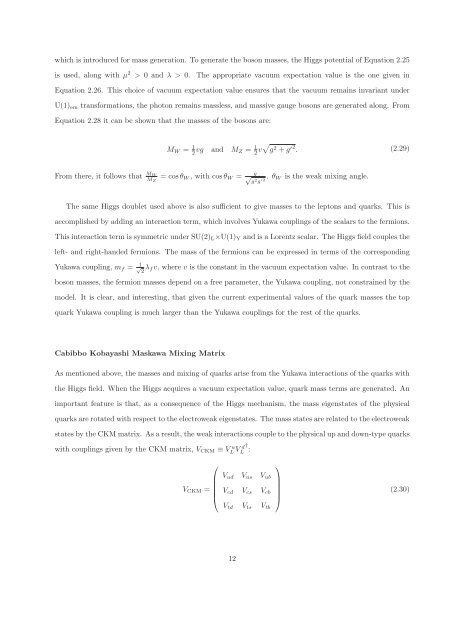CERN-THESIS-2012-153 26/07/2012 - CERN Document Server
CERN-THESIS-2012-153 26/07/2012 - CERN Document Server
CERN-THESIS-2012-153 26/07/2012 - CERN Document Server
Create successful ePaper yourself
Turn your PDF publications into a flip-book with our unique Google optimized e-Paper software.
which is introduced for mass generation. To generate the boson masses, the Higgs potential of Equation 2.25<br />
is used, along with µ 2 > 0 and λ > 0. The appropriate vacuum expectation value is the one given in<br />
Equation 2.<strong>26</strong>. This choice of vacuum expectation value ensures that the vacuum remains invariant under<br />
U(1)em transformations, the photon remains massless, and massive gauge bosons are generated along. From<br />
Equation 2.28 it can be shown that the masses of the bosons are:<br />
MW = 1<br />
2 vg and MZ = 1<br />
2 v g 2 + g ′2 .<br />
From there, it follows that MW<br />
MZ = cos θW, with cos θW = g √<br />
g2g ′2 . θW is the weak mixing angle.<br />
(2.29)<br />
The same Higgs doublet used above is also sufficient to give masses to the leptons and quarks. This is<br />
accomplished by adding an interaction term, which involves Yukawa couplings of the scalars to the fermions.<br />
This interaction term is symmetric under SU(2)L×U(1)Y and is a Lorentz scalar. The Higgs field couples the<br />
left- and right-handed fermions. The mass of the fermions can be expressed in terms of the corresponding<br />
Yukawa coupling, mf = 1<br />
√ 2 λfv, where v is the constant in the vacuum expectation value. In contrast to the<br />
boson masses, the fermion masses depend on a free parameter, the Yukawa coupling, not constrained by the<br />
model. It is clear, and interesting, that given the current experimental values of the quark masses the top<br />
quark Yukawa coupling is much larger than the Yukawa couplings for the rest of the quarks.<br />
Cabibbo Kobayashi Maskawa Mixing Matrix<br />
As mentioned above, the masses and mixing of quarks arise from the Yukawa interactions of the quarks with<br />
the Higgs field. When the Higgs acquires a vacuum expectation value, quark mass terms are generated. An<br />
important feature is that, as a consequence of the Higgs mechanism, the mass eigenstates of the physical<br />
quarks are rotated with respect to the electroweak eigenstates. The mass states are related to the electroweak<br />
states by the CKM matrix. As a result, the weak interactions couple to the physical up and down-type quarks<br />
with couplings given by the CKM matrix, VCKM ≡ V u L V d† L :<br />
⎛<br />
⎜<br />
VCKM = ⎜<br />
⎝<br />
Vud Vus Vub<br />
Vcd Vcs Vcb<br />
Vtd Vts Vtb<br />
12<br />
⎞<br />
⎟<br />
⎠<br />
(2.30)















